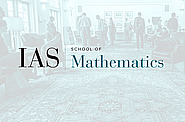Seminars Sorted by Series
Joint IAS/PU Analysis Seminar
Apr
21
2025
Joint IAS/PU Analysis Seminar
New and Old Observations About Morrey's Quasi-Convexity
Vladimir Sverak
4:30pm|Simonyi Hall 101 and Remote Access
Joint IAS/PU Arithmetic Geometry
Sep
23
2024
Joint IAS/PU Arithmetic Geometry
Selmer Ranks for Some Four-Dimensional Symplectic Galois Representations, in the Spirit of Bipartite Euler Systems
Naomi Sweeting
3:40pm|322 Fine Hall
Sep
30
2024
Joint IAS/PU Arithmetic Geometry
Perfectoidness via Sen Theory and Applications to Shimura Varieties
3:35pm|*Princeton University, Fine Hall 224*
Oct
07
2024
Joint IAS/PU Arithmetic Geometry
Hodge theory for non-Archimedean analytic spaces
3:35pm|Simonyi 101 and Remote Access
Oct
14
2024
Joint IAS/PU Arithmetic Geometry
On the converse to Eisenstein's last theorem
3:35pm|Simonyi 101 and Remote Access
Oct
21
2024
Joint IAS/PU Arithmetic Geometry
Excursion functions for p-adic reductive groups
3:35pm|*Princeton University, Fine Hall 224*
Oct
28
2024
Joint IAS/PU Arithmetic Geometry
Motives of the Hitchin system
Junliang Shen
3:35pm|Simonyi 101 and Remote Access
Nov
04
2024
Joint IAS/PU Arithmetic Geometry
Etale Cohomology of Shimura Varieties via Coherent Sheaves
3:35pm|*Princeton University, Fine Hall 224*
Nov
11
2024
Joint IAS/PU Arithmetic Geometry
The Fargues-Fontaine de Rham stack
Juan Esteban Rodriguez Camargo
3:35pm|Simonyi 101 and Remote Access
Nov
18
2024
Joint IAS/PU Arithmetic Geometry
Hodge structures and representation theory
3:35pm|*Princeton University, Fine Hall 224*
Nov
25
2024
Joint IAS/PU Arithmetic Geometry
Generalizations of Ohta's theorem for holomorphic modular forms on certain Shimura varieties
Marco Sangiovanni
3:35pm|Simonyi 101 and Remote Access
Dec
02
2024
Joint IAS/PU Arithmetic Geometry
Relative Rigid Cohomology via Motivic Homotopy Theory
Alberto Vezzani
3:35pm|*Princeton University, Fine Hall 224*
Dec
09
2024
Joint IAS/PU Arithmetic Geometry
Inertia Stacks, Gerbes and Intersection Cohomology
Michael Groechenig
3:35pm|Simonyi 101 and Remote Access
Jan
13
2025
Joint IAS/PU Arithmetic Geometry
New tensor categories : work of N. Harman, S. Kriz, A. Snowden, N. Snyder ... .
3:35pm|Bloomberg Hall Lecture Hall - note location Change
Jan
27
2025
Joint IAS/PU Arithmetic Geometry
Poincare Duality for pro-etale Q_p-local systems
3:35pm|*Princeton University, Fine Hall 224*
Feb
03
2025
Joint IAS/PU Arithmetic Geometry
Geometric Arthur Parameters
3:35pm|*Princeton University, Fine Hall 224*
Feb
10
2025
Joint IAS/PU Arithmetic Geometry
Arithmetic Gromov--Witten invariants
Kirsten Wickelgren
3:35pm|*Princeton University, Fine Hall 224*
Feb
17
2025
Joint IAS/PU Arithmetic Geometry
Local Monodromy of constructible sheaves
Deepam Patel
3:35pm|Simonyi 101 and Remote Access
Feb
24
2025
Joint IAS/PU Arithmetic Geometry
Higher coherent cohomology in weight one
Si-Ying Lee
3:35pm|Simonyi 101 and Remote Access
Mar
03
2025
Joint IAS/PU Arithmetic Geometry
Some remarks on the cohomology of proetale local systems
David Hansen
3:35pm|*Princeton University, Fine Hall 224*
Mar
10
2025
Joint IAS/PU Arithmetic Geometry
Malle’s conjecture for function fields
Ishan Levy
3:35pm|Simonyi 101 and Remote Access
Mar
24
2025
Joint IAS/PU Arithmetic Geometry
Moduli space with abelian motives
Victoria Hoskins
3:35pm|Simonyi 101 and Remote Access
Mar
31
2025
Joint IAS/PU Arithmetic Geometry
Fourier theory for families of p-divisible rigid analytic groups
Pol van Hoften
3:35pm|*Princeton University, Fine Hall 224*
Apr
07
2025
Joint IAS/PU Arithmetic Geometry
Real groups, symmetric varieties, quantum groups and Langlands duality
3:35pm|Simonyi 101 and Remote Access
Apr
14
2025
Joint IAS/PU Arithmetic Geometry Seminar
Jan
23
2023
Joint IAS/PU Arithmetic Geometry Seminar
Dual Abelian Varieties Over a Local Field Have Equal Volumes
4:30pm|Princeton University, Fine Hall 314
Joint IAS/PU Groups and Dynamics Seminar
Oct
08
2024
Joint IAS/PU Groups and Dynamics Seminar
Non-escape of Mass for Arithmetic Quantum Limits on Hyperbolic 4-Manifolds
Alexandre de Faveri
4:30pm|Simonyi 101
Oct
15
2024
Joint IAS/PU Groups and Dynamics Seminar
Closure of Orbits of the Pure Mapping Class Group on the Character Variety
Alireza Salehi Golsefidy
5:00pm|Simonyi 101
Oct
22
2024
Joint IAS/PU Groups and Dynamics Seminar
Algebraic Equations Characterizing Hyperbolic Surface Spectra
Anshul Adve
4:30pm|314 Fine Hall
Oct
29
2024
Nov
05
2024
Joint IAS/PU Groups and Dynamics Seminar
Stable Invariants of Words from Random Matrices
4:30pm|314 Fine Hall
Nov
12
2024
Joint IAS/PU Groups and Dynamics Seminar
Furstenberg Entropy Spectrum of Stationary Actions
Tianyi Zheng
4:30pm|Simonyi 101
Nov
19
2024
Joint IAS/PU Groups and Dynamics Seminar
Spanning Trees of Simple Planar Graphs
Alex Kontorovich
4:30pm|314 Fine Hall
Dec
03
2024
Joint IAS/PU Groups and Dynamics Seminar
On the Quantum Unique Ergodicity Conjecture for Hyperbolic Arithmetic Manifolds
1:30pm|Simonyi Classroom (S-114)
Dec
10
2024
Joint IAS/PU Groups and Dynamics Seminar
Corners with Polynomial Side Length
Noah Kravitz
4:30pm|Simonyi 101
Jan
21
2025
Joint IAS/PU Groups and Dynamics Seminar
Ramanujan Property and Edge Universality of Random Regular Graphs
Jiaoyang Huang
4:30pm|Simonyi 101
Jan
28
2025
Joint IAS/PU Groups and Dynamics Seminar
Measure Rigidity and Equidistribution of Fractal Measures on Homogeneous Spaces
Osama Khalil
4:30pm|Simonyi 101
Feb
04
2025
Joint IAS/PU Groups and Dynamics Seminar
Short Curves on Expander Surfaces
Jenya Sapir
4:30pm|314 Fine Hall
Feb
11
2025
Joint IAS/PU Groups and Dynamics Seminar
The Multilinear Circle Method and its Consequences in Pointwise Ergodic Theory
Mariusz Mirek
4:30pm|Simonyi 101
Feb
18
2025
Joint IAS/PU Groups and Dynamics Seminar
Minimum Entropies of Braids
Chi Cheuk Tsang
4:30pm|Simonyi 101
Feb
25
2025
Joint IAS/PU Groups and Dynamics Seminar
Rigidity for Boundary Actions and Classification in Low Dimensions
Federico Rodriguez-Hertz
4:30pm|Simonyi 101
Mar
04
2025
Joint IAS/PU Groups and Dynamics Seminar
Approximating Hyperbolic Lattices by Cubulations
Eduardo Reyes
4:00pm|Simonyi 101
Mar
11
2025
Joint IAS/PU Groups and Dynamics Seminar
The Support of Semiclassical Measures in Higher Dimensions
Elena Kim
4:30pm|Simonyi 101
Mar
18
2025
Joint IAS/PU Groups and Dynamics Seminar
Moments of Margulis Functions and Values of Ternary Quadratic Forms
Wooyeon Kim
4:30pm|Simonyi 101
